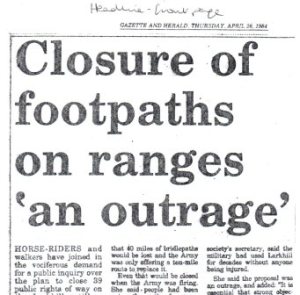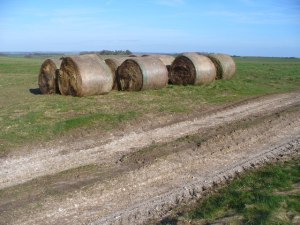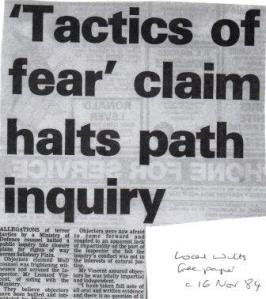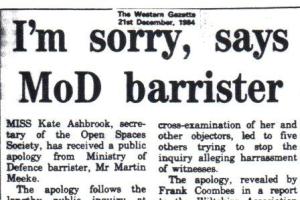Thirty years ago today, on 6 November 1984, a public inquiry opened in Devizes. It was to investigate the Ministry of Defence’s plans to close 32 miles of public paths across the Larkhill artillery ranges in Wiltshire.
I was there on behalf of the Open Spaces Society. I had been the general secretary for seven months. In that time I had made countless trips to Wiltshire, for meetings of the objectors and to visit parts of the vast site. I was particularly grateful to Bill and Ann Riley of Bradford-on-Avon who gave me tremendous support during the inquiry; they still battle for Wiltshire’s paths, byways and unclassified roads to this day.
The Larkhill firing ranges extend to 30,000 acres of which 10,000 acres were in the impact area. The MoD’s main argument was, predictably, that of safety but we pointed out that there had been no serious accidents from unexploded ammunition and that agricultural activities took place in the impact area.
Late in the day the MoD offered a compromise to buy off objectors. It said it would create a range-perimeter route and make the Ridgeway path flag-free from St Joan à Gores Cross to West Chisenbury in return for closing paths within the range. The Wiltshire Ramblers’ committee fell for this (although the organisation was split). The OSS, Wiltshire Association of Local Councils, Byways and Bridleways Trust, British Horse Society (BHS) and others held firm, arguing that much of the Ridgeway was already outside the range and therefore flag-free, and the remainder was free on the days when most use was made of it, ie weekends and bank holidays. Use of the perimeter route would be restricted by range by-laws—so this was no concession at all, merely a sop.
range-perimeter route and make the Ridgeway path flag-free from St Joan à Gores Cross to West Chisenbury in return for closing paths within the range. The Wiltshire Ramblers’ committee fell for this (although the organisation was split). The OSS, Wiltshire Association of Local Councils, Byways and Bridleways Trust, British Horse Society (BHS) and others held firm, arguing that much of the Ridgeway was already outside the range and therefore flag-free, and the remainder was free on the days when most use was made of it, ie weekends and bank holidays. Use of the perimeter route would be restricted by range by-laws—so this was no concession at all, merely a sop.
Evidence
The inquiry lasted for about a fortnight. I presented my evidence on day three and was given a rough time by the MoD’s barrister, Martin Meeke. Other objectors argued that they were bullied by him but the complaint was dismissed by the inspector, Leonard Vincent.
The BHS representative, Malcolm Firth (as a retired army major he was a useful ally), said that ‘Mr Meeke had made mincemeat of Miss Ashbrook’ (not the noun I would have chosen!). The press reported that Mr Meeke accused me ‘of talking nonsense’. He said my submission ‘was couched in emotive terms and called it shabby and ill-researched’.
Mr Meeke also alleged that my claim that active farming was taking place in the impact area was ‘utter rubbish’.
However, the inspector, accompanied by MoD and objectors, then visited the site and saw that there was indeed farming in the impact area. On 21 December 1984, the Western Gazette reported that I received a public apology from Mr Meeke.
Needless to say the MoD got what it wanted. The Secretary of State for Transport Peter Bottomley announced his decision in July 1986 and 32 miles of public paths were closed, leaving numerous dead ends on the edge of the range.
Achieved
In 2012 the Defence Infrastructure Organisation on behalf of MoD arranged for stopping up the tails with properly-dedicated alternative routes. This has now been achieved without controversy.
Nevertheless, the Larkhill battle was well worth the fight and I was glad to be a part of it. It’s sad though, that a place with such a lovely name should be subjected to battering by the military.




Thanks for a fascinating story Kate. A battle lost, but great experience for future ones.
I have just written this morning about the Infrastructure Bill which could lead to places like Larkhill being sold off to the private sector, with rights of way extinguished without appeal. While Save our Forests have successfully challenged the sale of the Public Forest Estate, there is no such commitment for former or “active but to be decommissioned” Defence land. This is a real threat both to nature but also to recreation, history and other values to the community.
I am sure the OSS is fighting for the protection of access, but who is standing up for nature and history?
Thanks Miles, yes Infrastructure Bill is a worry, will see what we can do before 3rd reading.
Great – let me know if you need any help.
Bill Riley has reminded me that we managed to save the most important route, the old Market Lavington to Orcheston Road (byways 29 and 29a (part)). Bill is still claiming unrecorded paths in the Salisbury Plain training area by way of compensation: since the Countryside and Rights of Way Act 2000 he has made applications for 126 upgrades and additions, 47 of them on MoD land, around half of which have been confirmed unopposed. Thank you Bill for this important work from which we all benefit.
If the Army had not been there it would have gone under the plough many years ago … sad but true …